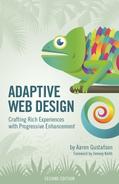Book Description
Building an elegant, functional website requires more than just knowing how to code. In Adaptive Web Design, Second Edition, you’ll learn how to use progressive enhancement to build websites that work anywhere, won’t break, are accessible by anyone—on any device—and are designed to work well into the future.
This new edition of Adaptive Web Design frames even more of the web design process in the lens of progressive enhancement. You will learn how content strategy, UX, HTML, CSS, responsive web design, JavaScript, server-side programming, and performance optimization all come together in the service of users on whatever device they happen to use to access the web.
Understanding progressive enhancement will make you a better web professional, whether you’re a content strategist, information architect, UX designer, visual designer, front-end developer, back-end developer, or project manager. It will enable you to visualize experience as a continuum and craft interfaces that are capable of reaching more users while simultaneously costing less money to develop. When you’ve mastered the tenets and concepts of this book, you will see the web in a whole new way and gain web design superpowers that will make you invaluable to your employer, clients, and the web as a whole. Visit http://adaptivewebdesign.info to learn more.
